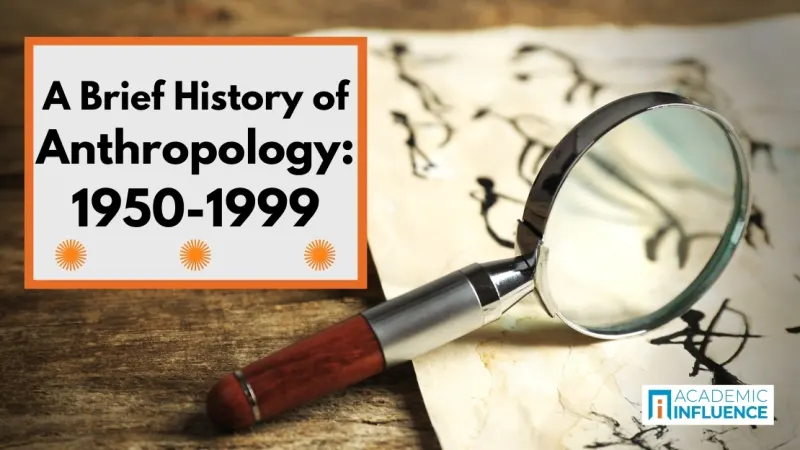A Brief History of Anthropology: 1950-2000

We explore the field of anthropology during the second half of the 20th century.
As structuralist views of anthropology played out in the 1950s, earlier Marxist-inspired ideas about the centrality of economics in social life crept into the study of anthropology. By the 1960s, American anthropologists Julian Steward , Roy Rappaport , and Marvin Harris helped shape what came to be called cultural ethology, or (more simply) cultural materialism. Cultural ethologists sought explanations for culture–the core focus of all of anthropology–in terms of the material conditions prevalent in a given society. Ethologists, for instance, pointed out that in India the belief that cows are sacred can be explained by their role as work animals in rural India and also by the use of cow dung as fuel. Given such economic incentives, it is much easier to understand why cows are treated with high regard in such cultures. It makes economic sense.
Interested in exploring the field of anthropology as an undergraduate? Find out How to Major in Anthropology.
Ethology in anthropology dominated studies in the 1960s and remains an important strand of anthropological research today. But by the 1970s still different ideas were entering the frequently changing field. Importantly, the American anthropologist Clifford Geertz saw the use of symbols as widely influential in cultures. Geertz prominently studied the culture of the people of Bali in Indonesia. In perhaps his most famous case study, Geertz examined the cultural practice of cock-fighting as prism through which to understand broader cultural belief and practice in Bali.
Victor Turning in Britain also embraced a symbolic understanding of culture, and thus in Europe as well as in the United States, symbolic anthropology took shape. Geertz’s book The Interpretation of Cultures described, as he put it, the anthropologist’s ideal of providing a “thick description” of a particular culture by carefully observing practices to find the symbolic and often hidden meanings that glue people together in culture. Symbolism then laid the groundwork for yet more abstract ideas to influence the course of anthropology.
Interested in earning an advanced degree in anthropology? Find out what you can do with a Master’s Degree in Anthropology?
By the 1980s, anthropology had, charitably speaking, become a diverse field with an expansive set of sub fields dedicated to different conceptual schemata which defined culture and provided a research program for exploring and understanding it. But this diversity, arguably, also illuminated the field’s difficulty in settling on a particular normative definition of culture and how to understand it. It was perhaps inevitable, therefore, that a general skepticism of normative definitions and an unchanging cannon would eventually emerge in the field. And it did. The 1980s initiated the beginning of what we call “postmodernism” in anthropology, a research agenda that seeks to understand society and culture not through a singular scientific lens but rather from the perspective of relativism, where there is no one true view of things.
Postmodernism in academia in general is marked by a distrust of science and rationality in the Enlightenment tradition. To the postmodernist view, these forces merely provided a lens through which dominant Western values could be demonstrated as superior to non-Western values. In this vein, 19th and 20th century anthropological theories often served as rationalization for either the implicit or explicit relegation of other cultures. Post-modernist thinking in anthropology sought to overcome these biases by working to understand individual cultures on their own terms. This movement was seen as a reaction to the inherent relationship between cultural anthropology and colonialism.
Through the 1990s and up to the turn of the century, the different strands of anthropology formed different research agendas and argued different positions about how best to understand and reasearch cultur. Postmodernism continued to gain prominence, resulting in programs like deconstructionism, where the results of previous anthropological research are taken apart and examined (deconstructed), often resulting in insights about how the research itself may have affected or even harmed the culture it tried to examine. Certainly by the turn of the century, anthropology was actively engaged not just in all aspects of the study of living and historical cultures, but also in a soul-searching examination of itself.
Find out which influencers have most contributed to advancing the field of anthropology over the last two decades with a look at The Most influential People in Anthropology, for the years 2000–2020.
And to find out which schools are driving the anthropology field forward today, check out The Most Influential Schools in Anthropology, for the years 2000–2020.
Or, read on to find out about the next stage in the history of the anthropology discipline.
For study starters, influential books, and much more, check out our full collection of study guides.
Or get tips on studying, student life, and much more with a look at our Student Resources.